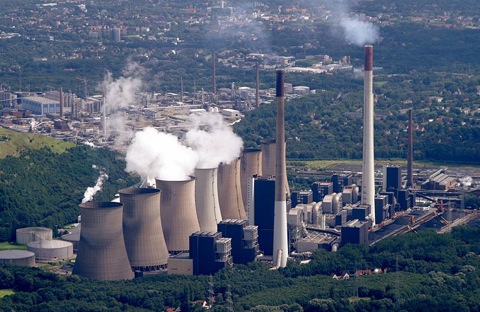How Much Should We Leave in the Ground?
9 Jun, 2009 02:48 pm
Here are some estimates for how much fossil fuel we can use, and a call for a global moratorium on new prospecting.
 |
One of the papers, by Myles Allen and others(1), suggests that we can burn, at most, another 400-500 billion tonnes of carbon at any time between now and the extinction of humanity if we want to avoid two degrees of warming. The other, by Malte Meinshausen and others(2), suggests that producing 1000 billion tonnes of CO2 between 2000-2050 would give us a 25% chance of exceeding two degrees. That?s a lot less than Allen?s estimate, as one tonne of carbon produces 3.667 tonnes of CO2 when it?s burnt: 1000 billion tonnes of CO2 arises from 273 billion tonnes of carbon.
But let?s err on the side of valour and use Allen?s figures. Moreover, let?s disregard all other greenhouse gases (which, he suggests, should reduce the total CO2 budget to under 400 billion tonnes). How does his maximum allowance of carbon compare with known reserves of fossil fuel?
Let me make two things clear before I make this calculation. First, reserves are not the same as resources. A resource is the total amount of a mineral found in the earth?s crust. A reserve is the part of the resource which has been identified, quantified and is cost-effective to exploit. In most cases this is likely to be a small percentage of the total resource.
Secondly, there is some controversy over the official figures for fossil fuel reserves. This is especially the case for oil, as the members of OPEC are extremely secretive about how much they possess. But for the sake of argument, let?s take them at face value.
According to the World Energy Council:
global reserves of coal amount to 848 billion tonnes(3)
global reserves of natural gas are 177,000 billion cubic metres(4)
global reserves of crude oil are 162 billion tonnes(5)
Because the calculations are much harder and the quantities involved less certain, I am ignoring unconventional sources of fossil fuel, such as tar sands, oil shales, bitumens and methane hydrates, as well as liquid natural gas resources.
On average, one tonne of coal contains 746 kg carbon(6)
One cubic metre of natural gas contains 0.49 kg carbon(7)
The figure for oil is less certain, because not all of its refinery products are burnt. But the rough calculation here(8) suggests that the use of a barrel of oil releases 317kg of CO2. Depending on the density of the oil, there are roughly 7 barrels to the tonne, giving an approximation of 2219kg CO2, or 605kg of carbon.
So the carbon content of official known reserves of coal, gas and oil amounts to:
848 x 0.746 = 633
+
177,000 x 0.00049 = 87
+
162 x 0.605 = 98
Total conventional fossil fuel reserves therefore contain 818 billion tonnes of carbon.
Even ignoring all unconventional sources and all other greenhouse gases and taking the most optimistic of the figures in the two Nature papers, we can afford to burn only 61% of known fossil fuel reserves between now and eternity.
Or, using Meinshausen?s figure, we can burn only 33% between now and 2050. Sorry - 33% minus however much we have burnt between 2000 and today.
So the question which arises is this: which fossil fuel reserves will we decide not to extract and burn? There is, as I have argued before(9), no point in seeking to reduce our consumption of fossil fuels unless we also seek to reduce their production. Yet, apart from the members of OPEC (who do it only to shore up the price), no government is attempting to limit the amount of fuel extracted. Far from it; they all pursue the same strategy as the United Kingdom: to ?maximise economic recovery?(10).
The test of all governments? commitment to stopping climate breakdown is this: whether they are prepared to impose a limit on the use of the reserves already discovered, and a permanent moratorium on prospecting for new reserves. Otherwise it?s all hot air.
References:
1. http://www.nature.com/nature/journal/v458/n7242/full/nature08019.html
2. http://www.nature.com/nature/journal/v458/n7242/full/nature08017.html
3. http://www.worldenergy.org/publications/survey_of_energy_resources_2007/coal/627.asp
4. http://www.worldenergy.org/publications/survey_of_energy_resources_2007/natural_gas/664.asp
5. http://www.worldenergy.org/publications/survey_of_energy_resources_2007/crude_oil_and_natural_gas_liquids/638.asp
6. http://bioenergy.ornl.gov/papers/misc/energy_conv.html
7. http://bioenergy.ornl.gov/papers/misc/energy_conv.html
8. http://numero57.net/?p=255
9. http://www.monbiot.com/archives/2007/12/11/rigged/
10. http://www.berr.gov.uk/files/file39387.pdf
Originally published on Monbiot.com
George Monbiot is the author of the best selling books Heat: how to stop the planet burning; The Age of Consent: a manifesto for a new world order and Captive State: the corporate takeover of Britain; as well as the investigative travel books Poisoned Arrows, Amazon Watershed and No Man?s Land. He writes a weekly column for the Guardian newspaper.






